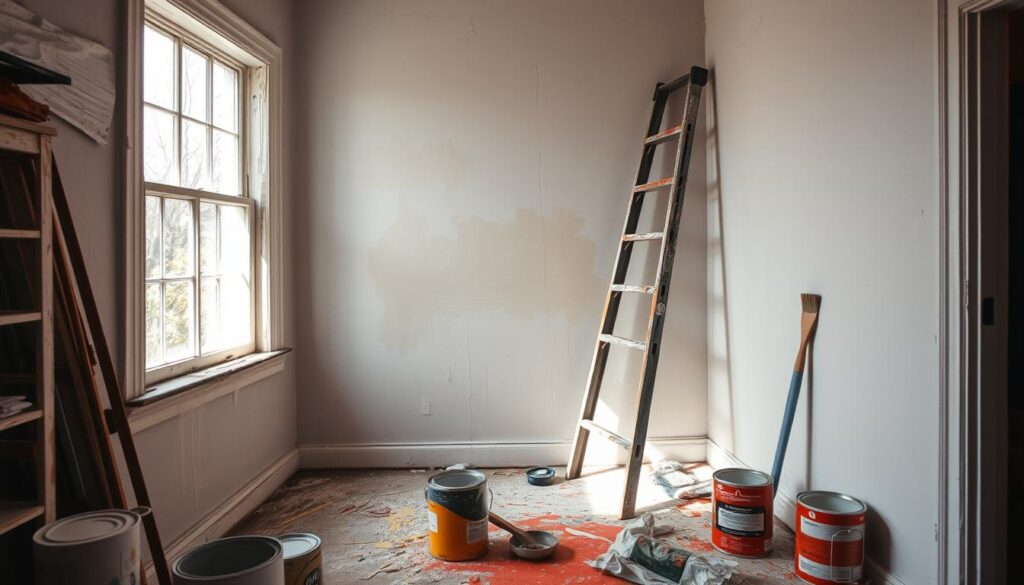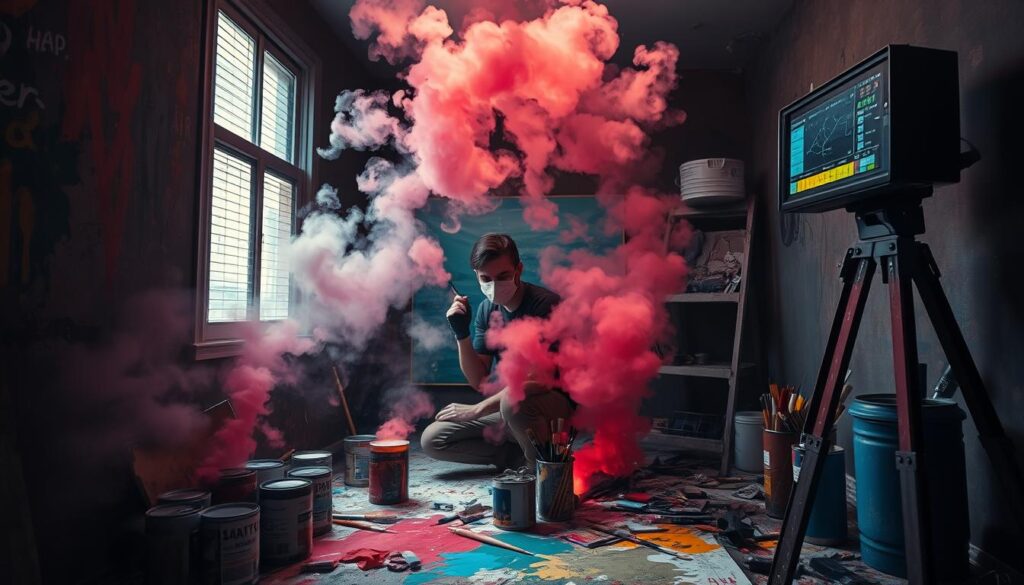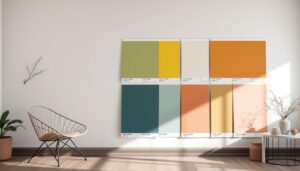Did you know that nearly 50% of homeowners experience dissatisfaction with their paint jobs, often due to avoidable mistakes? For residents in Bulleen, this can mean wasted time and money, especially considering how important a flawless finish can be for enhancing the beauty of your home. Understanding the Common Painting Mistakes Homeowners Make is crucial in achieving that perfect look.
This article aims to inform you about the common pitfalls and provide effective Painting Tips for Bulleen Residents. By recognizing these errors, you can avoid them in your next painting project and ensure a successful transformation for your living space. Prepare to elevate your painting skills and achieve results that make you the envy of the neighborhood.
Key Takeaways
- Learning how to prepare surfaces correctly is vital for quality results.
- Choosing the right type of paint can significantly impact your project.
- Mastering proper application techniques ensures an even finish.
- Inadequate ventilation can lead to health risks during painting.
- Neglecting cleanup can result in long-term damage to your surfaces.
- Recognizing the right weather conditions is crucial for outside painting jobs.
- Skipping protective measures can lead to costly mistakes.
Introduction to Painting Mistakes in Bulleen
Many homeowners in Bulleen look to enhance their living spaces through painting projects. Unfortunately, several Bulleen Painting Mistakes frequently crop up, often derailing the intended improvements. Ensuring the right approach to painting is essential for achieving high-quality results.
Common issues include selecting inappropriate paint types and neglecting surface preparation. These mistakes can lead to less than satisfactory outcomes and potential additional costs. By adopting practical Home Improvement Tips, you can streamline your painting process and achieve the desired finish for your property.
Focusing on the right techniques, materials, and adequate preparation can significantly transform your home’s appearance. Awareness of these frequent pitfalls prepares you to navigate the painting landscape in Bulleen more effectively.
Understanding the Importance of Proper Surface Preparation
Proper surface preparation is a vital step in achieving a successful painting project. Neglecting this aspect can lead to problems like peeling, blistering, and an overall unsatisfactory finish. To ensure the best results, it’s crucial to follow effective surface preparation steps that lay a solid foundation for your paint job.
Key Steps in Surface Preparation for Painting
Implementing thorough surface preparation steps not only enhances the appearance of your paint job but also prolongs its life. The following steps can help you achieve the desired outcome:
- Start by cleaning surfaces to remove dirt and dust that could show through paint.
- Assess and repair any damages, ensuring a smooth, even base for your paint.
- Applying primer is essential for enhancing adhesion and achieving an even color. Skipping this step often leads to a blotchy appearance.
- Use painter’s tape where necessary to achieve clean lines and prevent paint from getting on unintended surfaces, such as the ceiling.
- Select the correct type of brush specific to the paint being used for effective application.
Common Misconceptions About Surface Preparation
Many homeowners hold misconceptions regarding proper surface preparation. Understanding these can prevent costly mistakes:
- Thinking that a simple wash is sufficient for cleaning surfaces can lead to improper surface preparation. Thorough cleaning is necessary.
- Believing that primer is optional can affect the final look and durability of painted surfaces.
- Assuming that all paints are interchangeable; using the wrong type of paint can cause unforeseen issues.
- Overbrushing, or excessively applying paint to drying surfaces, contributes to uneven and unprofessional appearances.
- Disregarding weather conditions for outdoor projects can lead to premature cracking and fading of your paint job.
Common Painting Mistakes Homeowners Make
Many homeowners in Bulleen encounter various Common Mistakes in Painting that can undermine the quality of their efforts. A staggering 89% of homeowners overlook the importance of ensuring wall colors complement their decor, which can lead to significant clashes. Additionally, 70% use incorrect brushes during their painting projects, resulting in unsightly paint spills.
Another frequent error involves neglecting essential preparation work. Statistics show that 78% of homeowners skip these crucial steps, directly affecting the durability of their paint jobs. Without using painter’s tape, which 65% of homeowners disregard, there’s a higher chance of paint bleeding and resulting in messy finishes.
Being impatient also wreaks havoc, as 81% of homeowners attempt to paint over a wet surface, risking severe surface defects. Mixing primer and paint types is a mistake made in 43% of projects, leading to premature fading on specific surfaces. Choosing inappropriate paint sheen further complicates matters. For instance, using flat paint in high-traffic areas risks wear and tear, while semi-gloss is better suited for doors and trim.
Prioritizing quality is essential; opting for cheap brushes and rollers can lead to poor-quality results due to lacking coverage and longevity. Furthermore, painting techniques matter. Many homeowners apply paint haphazardly or too thickly at once, resulting in wastage and uneven applications.

Among rookie mistakes, leaving paint lids off and neglecting to secure pets stand out. You may inadvertently bump your ceiling when painting, creating the need for extra touch-ups. Over-brushing can cause unsightly marks, particularly on wood surfaces.
Extreme temperatures can also adversely affect your project. Cold weather risks damaging paint and hindering proper drying. Letting the roller touch the floor may trap dirt or lint, ruining your clean lines. Testing the surface of popcorn ceilings before painting can prevent peeling and damage.
Avoiding glossy finishes without proper preparation can lead to inadequate adherence. Lack of light during painting often conceals imperfections that become glaringly obvious under bright light later. Finally, it’s critical to maintain a wet edge by rolling in one direction to avoid overlap marks and ensure a seamless finish.
| Error Type | Percentage of Homeowners Affected |
|---|---|
| Failing to match wall colors with decor | 89% |
| Using the wrong brush | 70% |
| Skipping essential prep work | 78% |
| Not using painter’s tape | 65% |
| Painting over a wet surface | 81% |
| Mixing primer and paint types | 43% |
Choosing the Wrong Paint for Your Project
Selecting the right paint is crucial for achieving lasting results in any home improvement project. Making informed choices can prevent common pitfalls associated with choosing the wrong paint. Homeowners should be aware of several factors that directly impact their painting outcomes.
Factors to Consider When Choosing Paint
When evaluating paint options, keep the following factors in mind:
- Finish Type: Decide among matte, satin, or glossy finishes based on the area and desired look.
- Durability: Choose high-quality paints designed for specific environments to ensure longevity.
- Color Theory: Consider how colors affect mood and lighting in your space.
- Climate Impact: Know that Albury’s hot summers and cold winters can affect paint performance, making the right selection even more vital.
- Paint Compatibility: Different surfaces may require specific types of paint, such as latex or oil-based formulations.
Types of Paint Suitable for Different Environments
Understanding which type of paint to use in various locations within your home is essential. Below is a comparison of common paints suitable for interior and exterior applications:
| Type of Paint | Best Suited For | Notes |
|---|---|---|
| Latex Paint | Interior Walls | Fast drying and easy to clean up with water. |
| Oil-Based Paint | Woodwork and Trim | Offers a hard, durable finish but takes longer to dry. |
| Exterior Paint | Outdoor Surfaces | Formulated to withstand weather conditions. |
| Primer | Preparation Method | Enhances adhesion and can improve durability, essential when choosing the wrong paint. |
| Specialty Paints | High-moisture Areas | Mildew-resistant options are ideal for bathrooms and kitchens. |
Mastering Paint Application Techniques
When it comes to achieving a flawless paint job, mastering paint application techniques makes a significant difference. This involves having the right painting tools and methods at your disposal. Selecting quality equipment not only enhances your efficiency but ensures a professional finish that elevates the visual appeal of your space.
Tools You Need for a Flawless Application
Quality painting tools can impact the outcome of your project. Here are some essential tools to consider:
- Angled Brush: A 2 to 2.5-inch angled brush is ideal for edging and detail work.
- Roller: A 9-inch roller provides excellent coverage for larger areas.
- Medium Roller Covers: Medium 3/8-inch microfiber roller covers are effective for a smooth finish.
- Roller Grids: These fit inside a 5-gallon bucket, reducing splatter and paint refills.
- Drop Cloths: Canvas or paper-backed plastic cloths protect your floors during the process.
Methods for Even Distribution of Paint
Employing the correct methods can ensure even paint distribution while minimizing streaks or uneven coverage. Consider the following techniques:
- Proper Brush Loading: Dip the brush about two fingers into the paint, wiping excess off to avoid drips.
- The “W” Pattern: Use this technique while rolling to distribute paint evenly across surfaces.
- Consistent Stroke: Maintain a steady hand, avoiding over-brushing that can create drag marks and streaks.
- Priming: Apply a coat of primer for better adhesion, especially when covering imperfections or stains.
- Selection of Finish: Choose a paint finish based on the room’s requirements, as different areas need different durability.
| Tool | Purpose | Recommended Size |
|---|---|---|
| Angled Brush | Edging and detail work | 2 to 2.5 inches |
| Roller | Covering large surfaces | 9 inches |
| Medium Roller Cover | Smooth finish | 3/8 inch (microfiber) |
| Roller Grid | Reduce splatter | Fits inside 5-gallon bucket |
| Drop Cloth | Protect floors | Various sizes |
The Risks of Inadequate Ventilation During Painting
Inadequate ventilation during painting projects can lead to serious health risks that you may not immediately recognize. Poor airflow can result in the buildup of harmful fumes, posing threats to your respiratory health. Understanding why ventilation matters, along with effective ventilation tips for painters, can enhance both safety and comfort during your painting experience.
Why Ventilation Matters for Your Health
When painting indoors, the fumes released from paint can cause a range of health issues, including respiratory irritation, headaches, dizziness, and nausea. Long-term exposure may lead to more severe problems such as asthma and nerve damage. Furthermore, other serious conditions, such as liver and kidney damage, have been linked to prolonged inhalation of volatile organic compounds (VOCs), which are frequently found in traditional paints. Keeping air circulation optimal prevents these toxins from accumulating and helps maintain a healthier working environment.
How to Ensure Proper Ventilation in Your Home
Taking proactive steps to improve ventilation during painting can mitigate risks significantly. Here are some effective ventilation tips for painters:
- Open windows to allow fresh air to flow in, creating a cross-breeze that disperses fumes.
- Utilize fans to enhance air circulation, helping to carry away potentially harmful vapors.
- Consider using low or no-VOC paints to reduce the release of toxic chemicals during and after your project.
- Ensure proper humidity levels in your workspace, as adequate ventilation can help prevent discomfort from heat and moisture.
Taking these measures not only promotes a healthier environment but also aids in achieving a better finish on your walls. Inadequate ventilation risks not only compromise your health but can also lead to uneven drying and bubbling finishes on painted surfaces.

Neglecting Cleanup: An Often Overlooked Step
Cleanup After Painting is a vital aspect that many homeowners frequently overlook. Ensuring proper cleanup not only enhances the overall aesthetic but also promotes safety and longevity of your work. After you have completed your painting project, taking the time to address the importance of post-paint cleanup cannot be understated.
Improper disposal of leftover paint and materials can pose environmental hazards. Responsible disposal methods should be implemented to avoid potential damage to nature. Cleaning brushes and tools promptly is crucial for maintaining their quality and performance. Dried paint can ruin brushes, making them ineffective for future jobs.
Avoiding damage to freshly painted surfaces during cleanup is another essential practice. Use soft cloths or sponges to gently wipe away any accidental spills without disturbing newly applied paint. This method preserves the professional finish you worked hard to achieve.
The following table outlines effective cleanup practices and their respective significance:
| Cleanup Practice | Significance |
|---|---|
| Disposal of Paint | Prevents environmental harm and adheres to local regulations. |
| Cleaning Brushes | Maintains tool effectiveness and extends their lifespan. |
| Protecting Surfaces | Minimizes damage to painted areas and ensures a tidy finish. |
| Removing Tape | Prevents peeling of fresh paint and allows for clean edges. |
| Patching Up | Ensures all spots are attended to, leading to a professional look. |
Emphasizing the Importance of Post-Paint Cleanup contributes significantly to creating a safe and visually pleasing environment after a painting project. By making this effort, you ensure that your space remains beautiful and functions well for years to come.
Cutting Corners: When Shortcuts Lead to Problems
When undertaking a painting project, many homeowners unknowingly fall into the trap of cutting corners to save time and money. This practice often leads to a cascade of problems, undermining the integrity of your home and its aesthetics. Being aware of common areas where corners are cut can help you avoid long-term painting issues.
Common Areas Where Homeowners Cut Corners
- Skipping Surface Cleaning: Neglecting to clean surfaces can lead to paint adhesion failures.
- Using Low-Quality Materials: Opting for cheap paints results in lower durability and frequent touch-ups.
- Rushing the Preparation Process: Skipping priming or not allowing coat drying can cause peeling paint.
- Ignoring Local Building Codes: Failure to comply may introduce future fines and complications during resale.
- Overlooking Waterproofing: Inadequate measures in wet areas can spawn mold and mildew problems.
The Long-Term Impact of Cutting Corners
Cutting corners in painting can have significant ramifications. The immediate allure of saving time and expenses fades quickly as long-term painting issues arise, like:
| Issue | Impact |
|---|---|
| Peeling Paint | Requires complete repainting, leading to increased costs and inconvenience. |
| Mold Growth | Can result in health risks and costly remediation efforts, affecting home value. |
| Frequent Repairs | Leads to continuous expenses due to premature wear and tear on finishes. |
| Violation Fines | Homeowners may face unexpected fines due to non-compliance with building codes. |
| Structural Damage | Prolonged moisture exposure can compromise structural integrity, especially in new builds. |
Prioritizing quality over speed ensures a more successful and lasting painting project. Investing time and resources correctly pays dividends in the durability and beauty of your home.
Ignoring Weather Conditions Before Painting
Understanding weather conditions for painting is crucial to achieving a successful project. Humidity, temperature, and seasonal variations can significantly influence the painting process. Unfavorable weather may lead to issues such as poor adhesion, uneven drying, or compromised finish durability. Familiarizing yourself with local climate patterns not only aids in planning but ensures optimal results.
How Weather Affects the Painting Process
Different weather conditions can make or break your painting experience. High humidity can prevent paint from drying properly, resulting in a sticky finish that takes longer to set. Cold temperatures may lead to inadequate curing and an increased risk of cracks or peeling. On the contrary, extremely hot weather could cause your paint to dry too quickly, inhibiting proper adherence and the overall finish quality.
Indicators That It’s the Right Time to Paint
Knowing the best times to paint can greatly enhance the quality of your work. Look for days with moderate temperatures, ideally between 50°F to 85°F (10°C to 29°C). Low humidity levels are preferred, as they promote even drying. Additionally, check your local forecasts to avoid periods of rain or strong winds, which can disrupt your painting project.
Failing to Protect Surfaces During Painting
Engaging in a painting project without proper precautions may result in damage to surrounding surfaces. Protecting surfaces when painting not only saves time in cleanup but also ensures a professional finish. This section outlines best practices for surface protection, keeping your space pristine while you focus on the task at hand.
Best Practices for Surface Protection
Implementing effective surface protection tips is essential for safeguarding your home. Consider the following best practices:
- Cover floors with drop cloths or plastic sheeting to prevent paint splatters.
- Use painter’s tape to mask off areas such as trims or windows.
- Protect furniture by moving it away from the painting area or covering it thoroughly.
- Apply primer before repainting glossy or oil-based surfaces for better adhesion.
- Ensure proper ventilation and optimal temperature conditions to improve paint adhesion.
Common Mistakes in Surface Protection
Even experienced painters may overlook certain precautions. Here are common pitfalls to avoid:
- Neglecting to use painter’s tape, which can lead to uneven lines and smudges.
- Forgetting to prime walls, causing paint not to adhere properly.
- Using cheap brushes or rollers that offer poor coverage and increase the risk of paint dropping.
- Overbrushing or painting without considering the existing paint sheen, leading to inconsistencies.
- Failing to protect adjacent areas, which could result in cleanup challenges later.
Conclusion
In summary of painting mistakes, it’s essential for Bulleen homeowners to recognize the critical aspects of a successful painting project. By paying close attention to surface preparation, applying appropriate techniques, and selecting the right materials, you can avoid the common pitfalls that lead to disappointing results. Properly measuring your surface area, using quality paint, and adequately protecting surrounding areas will set the foundation for a stunning finish.
Implementing these final painting tips can significantly enhance the longevity and appearance of your painted surfaces. Remember, neglecting small details such as cleaning brushes, protecting furniture, and allowing adequate drying time can have a considerable impact on your efforts. Taking the extra time to prepare not only saves you from headaches down the road but also ensures you achieve the professional look you desire.
For further inquiries or assistance as you embark on your painting endeavors, don’t hesitate to contact Prestige House Painting at 0466 344 447 or via email at info@prestigehousepainting.com.au. Implementing these guidelines will not only beautify your home but will also protect your investment for years to come.





